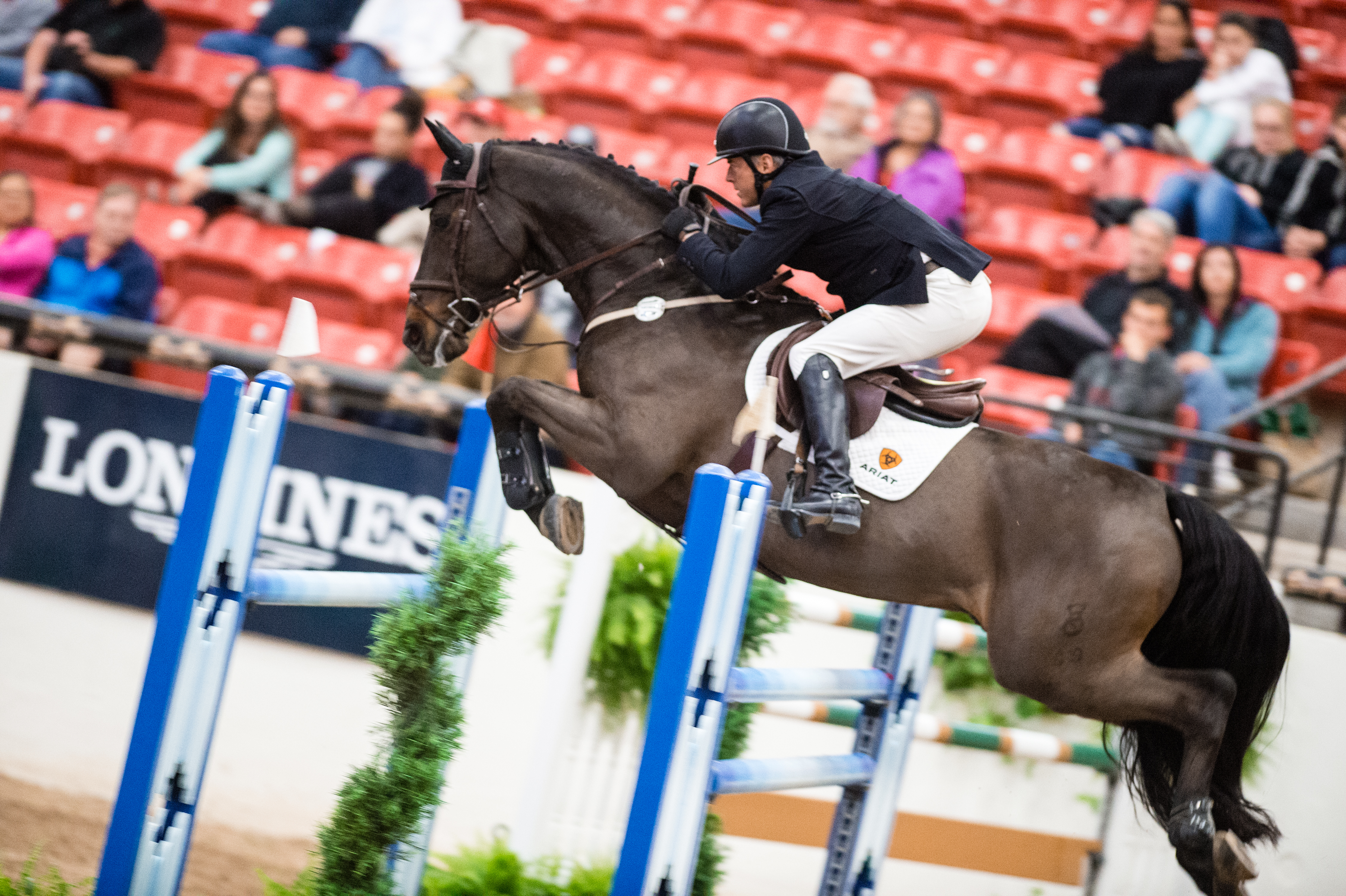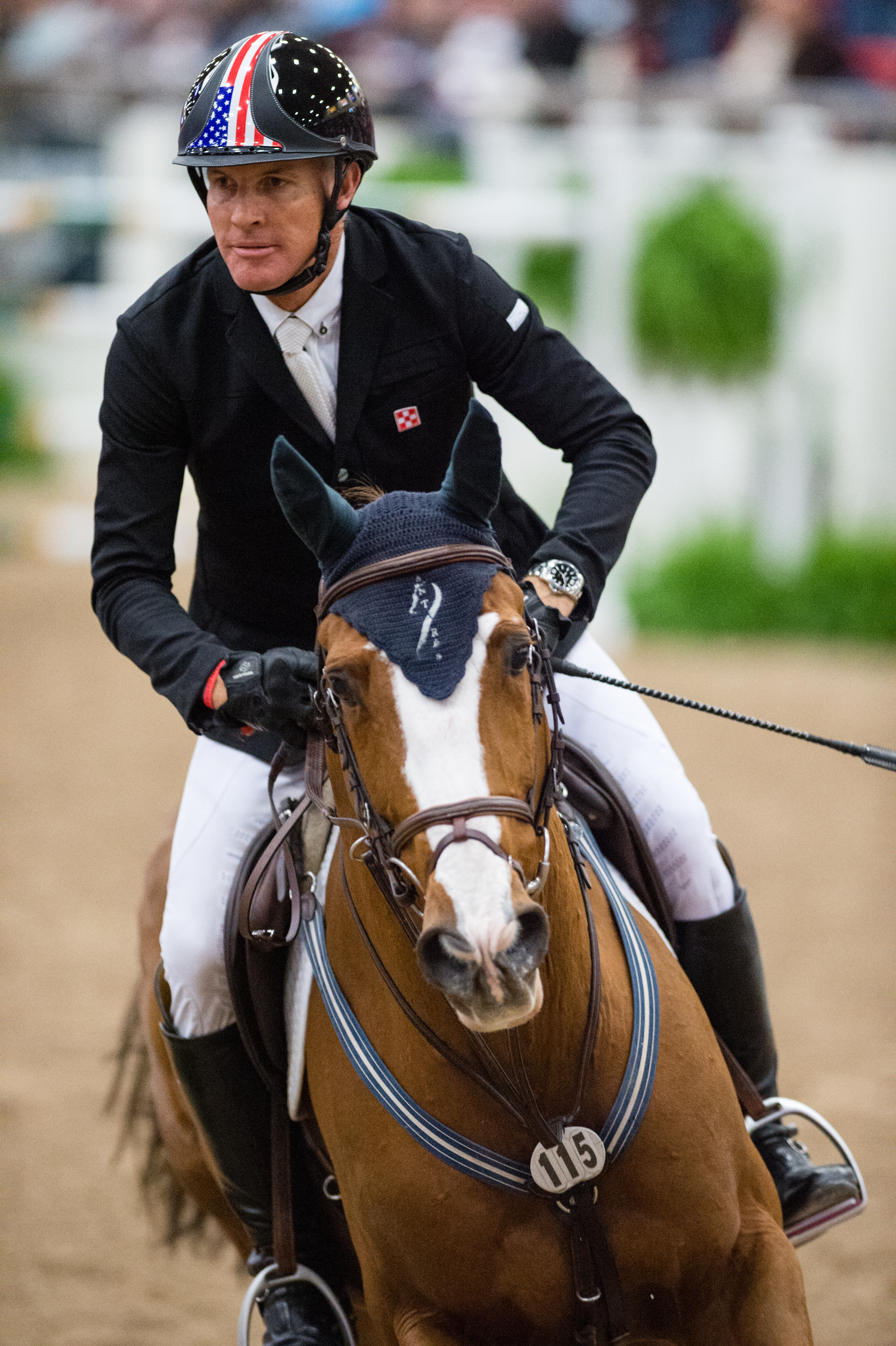
What are the best traits in a show jumping prospect? How do you prepare for a Nations Cup? Will the Thoroughbred make a comeback?
These were among the inquiries participants asked top pros in a highlight of the USHJA’s Emerging Jumper Rider Gold Star Clinic West. The January 20 Q&A took place during the four-day educational event held to rave reviews concurrent with the first week of the HITS Coachella Desert Circuit.
Lead clinician Richard Spooner was joined in the relaxed, fun discussion by 2008 Olympic team gold medalist Will Simpson; 2012 World Cup Champion and Olympian Rich Fellers; veteran Nations Cup rider Kirsten Coe; and USET High Performance team veterinarian, Geoff Vernon, DVM.
Priorities In A Prospect
“Heart” was the universal answer to what these professionals looked for in a prospect. “There’s no vet with a long enough needle, or long enough spurs, to reach the horse’s heart,” said Simpson. Spooner revealed why he had just spent three days emphasizing rideability during mounted sessions with the clinic’s participants. He prioritizes “affordability” and raw talent and relies on himself to develop enough rideability to harness it. “I’ll always sacrifice rideability because I can’t afford it! If it’s there in (an affordable) horse, somebody made a mistake.”
“Character, willingness to be trained and the feel of his jump,” were Coe’s list-toppers.
Dr. Vernon addressed the role of the vet check in high performance horses. Choosing between a horse that had the riders’ preferred traits and imperfect x-rays and a horse with relatively perfect x-rays but less of those qualities, he’d take the first one. “You don’t ride the x-rays. You ride the horse.”
Evolution of the Sport
“It’s headed in a fantastic direction,” said Spooner. “When I started there was no such thing as a professional rider. You found a way to make money and got to show a little bit, but there was no way to make a living strictly by showing horses. Even in Europe, it was sales, and in North America, it was training people. In the mid to late ’90s, there was a shift to where you could be a professional rider. At that moment, there was a huge change in in the quality of horseman. You had to be good or you wouldn’t make it.”
Fellers concurred. “The prize money has gone up so much, but so has the cost of horses. I’m excited. My son [Christopher] is also in the sport and, if he can cultivate good owners, there’s a chance for a decent living off of prize money.”
When Simpson started there was typically one grand prix a month. “If you won it, you were king for the month. Now, it’s more a sport of real quality riding. Luck is out the window.”
Speaking of a change he didn’t like, Spooner lamented that natural obstacles have “become obsolete.” Ditches, banks, Devil’s Dykes (a sunken obstacle in which horses jump a fence, take a couple of downward-sloping strides to a dry ditch, then a couple strides up to another fence) and events like the Parcours de Chasse (a speed class where jumping faults are converted into time. Courses often feature twisty turns and derby-style natural obstacles, such as banks, table tops and devil’s dykes)“separated the men from the boys and built character in horses.”

Evolution of Horses
Asked if the Thoroughbred would make a comeback, panelists said they already are, except not the “American Thoroughbred,” the fine-boned type found on the racetrack. Flexible is basically a Thoroughbred, noted Fellers of his World Cup champion and Olympic partner. Spooner said that course designers play a huge role in riding styles and in the horses most valued in the sport. With fences that “are so light, airy and easy to knock down, breeders in Europe figured out they had to add more blood.” The result is closer to the American Thoroughbred of yore, but “with bigger bones and slightly easier to train.”
Preparing for a Big Class
With the Nations Cup awaiting them as the clinic’s finale, Gold Star riders sought preparation tips. “Work everything backward,” said Spooner. “Start with imagining the win and that will give you a road map.” Simpson applied that idea to ensuring that the horse’s conditioning would peak at the competition. Spooner shared his belief that “fitness makes a sound horse sounder.” There was consensus that a horse that can’t handle hard work on repeated days at home is probably not a suitable horse for a Nation Cup’s two-round format.
Mentally, Coe advised riders to treat it like a normal class and Simpson stressed consistency as a team member’s top trait.
Trail Riding
“Yes!” Was the resounding response when asked whether trail riding was part of their top horses’ routines. “I never go to the ring first,” said Fellers, explaining that, even at a show, he always seeks outside-the-ring work to start each day’s preparation. Spooner’s home stable is located in a high desert area near Los Angeles and walking up and down a nearby mountain is part of each horse’s day. “Coming down is especially good for their tendons and hand-walking up and down is wonderful for their mind and body.” When his longtime Grand Prix star Cristallo first joined them, Richard’s wife Kaylen spent several hours a day trail riding him to help settle him down.
“I’m known to throw my horses in the trailer and haul them somewhere for a good trail ride,” Simpson said. Along with the agility and fitness that comes from working on varied natural terrain, it fits with Will’s belief that “good cowboys can do most of their training at the walk.”
Rider Fitness
Spooner admitted that the only non-riding fitness he did was to “lie down and reach for my spurs every morning,” but he joined his contemporaries in saying that it’s important. Coe is a gym-hater, but works out regularly and Simpson likes tennis for quickness and reflexes. He makes a point of staying generally fit “for when something goes wrong on course.” Dr. Vernon recalled rooming with Canadian star Ian Millar during the Sydney Olympics. “Every morning, he was up early in his short-shorts stretching. It was quite a show! He says it’s the secret to his longevity.”
What to Look for In A First Job & How to Get It
Coe recounted repeatedly riding past Andre Dignelli’s barn at a show as a junior, working up the nerve to speak with him about a working student position. When she got it, “I did whatever I could to make him want to teach me.” Simpson advised, “Finding a place where you can learn something and make a contribution.”
“Start in the mail room,” Spooner said. His first “real job” was grooming for California pro Rob Gage. He next worked for Ian Millar, for what he recalled as $200 a week. It was tough to get by on that, but, “You can’t put a price on education and it’s something nobody can take away from you.”










